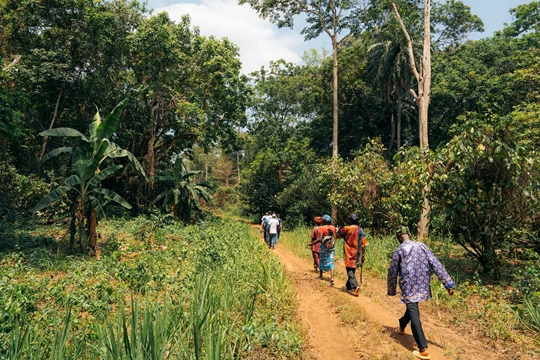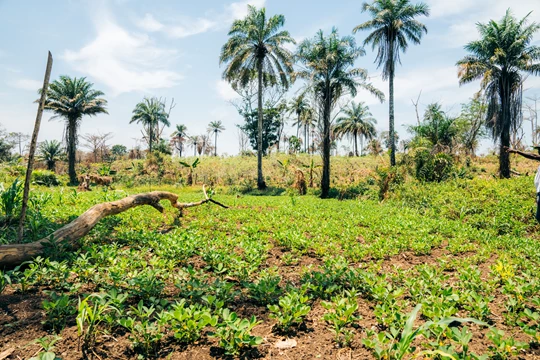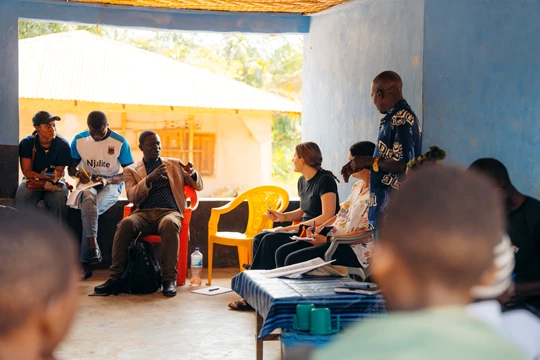A Delicate Balance: Livelihoods, Conservation, and Climate Change
The Gola Rainforest is home to rare wildlife, from pygmy hippos to pangolins and the striking White-necked Picathartes. But life in the forest-edge communities that surround the national park is becoming increasingly challenging – communities live in abject poverty, living in mud-brick homes with lack of water and sanitation, and far away from any form of healthcare. Cocoa farming is a vital source of income, yet global market prices are unpredictable. At the same time, climate change is bringing erratic rainfall, prolonged dry spells, and extreme weather, threatening crops, food security, and household incomes.
The challenge is clear: how can cocoa farming remain viable and profitable without putting further pressure on the forest?
A New Approach: Cocoa Farming That Works with Nature
That’s where agroforestry comes in. Instead of growing cocoa as a single crop, agroforestry combines cocoa with other trees and plants to improve soil, protect water sources, and create a healthier farming system. Farmers can grow valuable trees (like indigenous trees for medicinal use and fruit) alongside their cocoa, reducing reliance on a single income source. Plus, maintaining tree cover helps protect the rainforest and locks carbon in the soil, tackling climate change at the same time.
During our visit, we met farmers from 3 of the 32 communities across Malema and Gaura districts who are trialling these agroforestry techniques. The response has been overwhelmingly positive. The project is working directly with 128 pilot farmers, reaching a wider network of 3,000 community members. It’s also supporting vulnerable farmers—many of whom are women—who are keen to learn new agricultural techniques and increase their income in a way that safeguards the forest for future generations. A systems-strengthening approach is also integrated within project activities – working with cocoa cooperatives to ensure improved cocoa quality and processing. In addition, the project works with cooperative leadership to strengthen business and marketing skills to secure fair price and international market access.
Challenges on the Ground: Gender, Climate, and Adaptation
Shifting to agroforestry isn’t just about planting different crops—it’s also about addressing and adapting deep-rooted social norms. In Sierra Leone, cocoa farms are typically owned by men, while women earn their income from small-scale vegetable farming. Land ownership, access to training, and decision-making power are often unequal, meaning women risk being left behind in the transition to more sustainable cocoa farming. The project is actively tackling this by ensuring women are included in cocoa farming and leadership roles, opening up new economic opportunities.
Climate change is another growing challenge, and we saw first-hand how it’s affecting both farmers and the project’s six Agroforestry Officers, who each oversee between 5 and 6 communities. The longer dry season means improved irrigation is essential, yet erratic rainfall sees intense flooding in the rainy season, leaving remote communities largely inaccessible. One stark difference between the three communities we visited is those closer to the forest often have better soil and water access, while those further away faced limited access to water in the dry season. However, one of the project’s biggest strengths is its flexibility; GRC and RSPB are continuously adapting their approach to respond to such challenges swiftly.
Despite the challenging climate and geographic environment, momentum behind Cocoa’s Sweet Spot remains strong. Each of the focus group discussions we had demonstrated how farmers recognise the benefits of agroforestry, and that the longstanding partnerships between RSPB, GRC, and the communities has a significant impact as there is clear trust between communities and the project team, meaning any issues can be addressed quickly.
It’s clear this project about more than just growing cocoa —it’s about securing a future where cocoa farming and rainforest protection go hand in hand. If the second half of this project builds on the progress we saw last week, the future of cocoa farming in Gola could be as rich and thriving as the rainforest itself.









